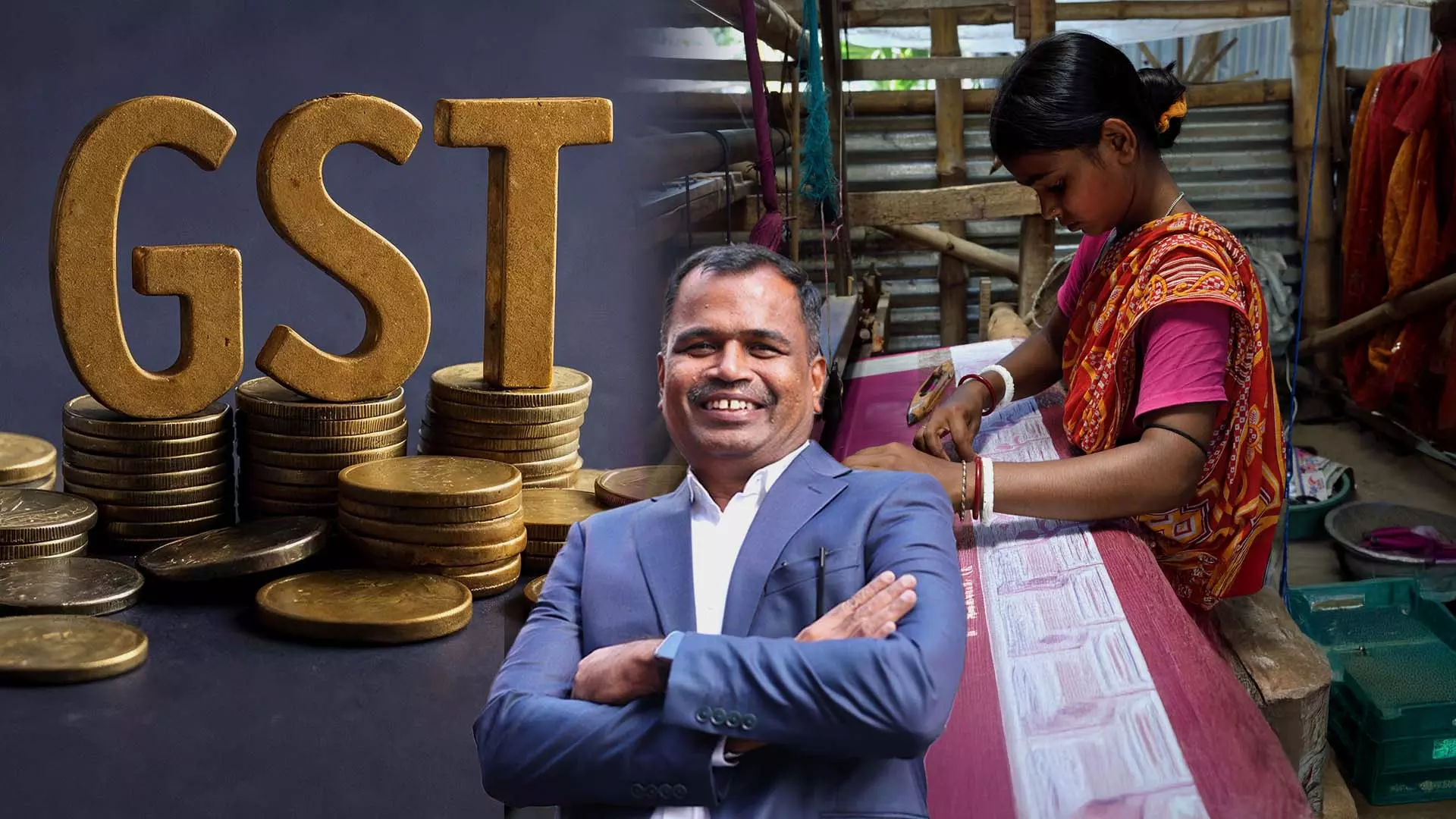
Tiruppur Exporters Association president KM Subramanian
Tiruppur textiles caught between GST relief and Trump tariff shock
GST Council fixes inverted duty woes, easing refunds and cash flow for Tiruppur exporters, but Trump’s 50 per cent tariff threatens crores in orders and jobs

The Federal spoke to KM Subramanian, president of the Tiruppur Exporters’ Association (TEA), on how a uniform 5 per cent GST rate on the man-made fibre (MMF) value chain could ease working capital stress, and how the recently announced 50 per cent US tariff could hit orders, margins, and jobs in the Tiruppur knitwear cluster.
How does the GST Council’s move to set a uniform 5% GST across the MMF chain address the inverted duty structure?
The 56th GST Council reforms have brought textile-focused changes. Earlier, yarn attracted 18% GST and fabric 12%; both are now at 5%. This reduces the accumulation of input tax credit and corrects the imbalance where buying duties were higher than selling duties. With lower rates across the chain, working capital improves and fund flow increases, which is positive for export business.
Tiruppur is largely cotton-focused. Will a 5% GST rate change the MMF mix?
Tiruppur is primarily cotton-oriented, but around 20% of production is MMF-based. The new rate will support MMF and help increase that share. It creates room to grow man-made fibre garments alongside cotton.
Will GST 2.0 translate into faster refunds and smoother cash flows?
Simplification, automation, and computerisation have been undertaken. The commitment is that 90 per cent of refunds will be processed quickly, with the balance released after document checks. This faster processing should ease liquidity for exporters.
How does India’s GST alignment compare with competitor countries?
The GST method is widely followed; the new structure brings India at par with competitor markets such as Bangladesh, Vietnam, Cambodia, and Sri Lanka.
What is the immediate impact of the 50 per cent US tariff announced in two tranches?
A 25 per cent tariff was first announced, followed by another 25 per cent on August 27, taking the total to 50 per cent. This is too high and could affect business for at least a year. Exporters will need to seek new markets like the EU, UK, and Australia. During this shift, there could be a loss of around ₹6,000–₹7,000 crore, and goods in production and transit may be impacted.
Tamil Nadu’s chief minister flagged a ₹3,000 crore potential loss. Why do you estimate ₹6,000–₹7,000 crore?
Tiruppur ships roughly ₹2,000 crore of goods to the US each month. The stock and order position varies by exporter; a precise estimate will be clearer in two to three weeks. Based on current run rates and pipeline exposure, the loss could be ₹6,000–₹7,000 crore over the adjustment period.
Will American consumers ultimately bear the cost of the tariff?
Yes. If a T-shirt that cost ₹100 earlier now costs ₹150, end consumers will face the burden, affecting their cash flows. Protests and marches are already visible in the US. Court observations have also questioned such duties and asked for a rethink. Brands will take individual calls: some, like Walmart, may try to hold prices; others, like Costco, may increase them. Ultimately, price increases are likely.
Will the tariff lead to job losses in Tiruppur, particularly among women workers?
Tiruppur operates as a cluster with about ₹45,000 crore in exports and ₹30,000 crore in domestic sales—around ₹75,000 crore in total. The cluster provides roughly one million direct jobs, with about 65 per cent women workers. The US accounts for about 30 per cent of exports (₹12,000–₹15,000 crore). There is already a need for more workers in the cluster, and orders can be managed by pivoting to other countries. On that basis, no job losses are expected, and orders are expected to rebalance in two to three months.
What relief measures have you sought from the Centre and the state?
Requests to the Centre include 5 per cent interest subvention, higher export rebates (RoSCTL/RoDTEP), and a new Focus Market Incentive for stressed markets. A 90–180 day moratorium on obligations has also been sought. From the state, requests include relief on electricity demand charges and worker-support packages; reference was made to other states (Odisha, Madhya Pradesh, Maharashtra) that provide wage support (e.g., ₹6,000 per worker per month) to factory employees.
Will increased automation in Tamil Nadu’s industrial units cause job losses?
Tamil Nadu continues to attract new investment and expand capacity. Automation is necessary largely because of workforce shortages, not to replace workers. It supports productivity and does not imply job losses in this context.
Does the GST relief offset the US tariff shock?
They are not comparable. The GST correction has been sought for two years and provides a long-term boost—higher turnover, improved profitability, and more job opportunities. The US tariff is a separate, external shock. The GST move strengthens the base; the tariff impact must be addressed through market diversification and policy support.
The content above has been transcribed using a fine-tuned AI model. To ensure accuracy, quality, and editorial integrity, we employ a Human-In-The-Loop (HITL) process. While AI assists in creating the initial draft, our experienced editorial team carefully reviews, edits, and refines the content before publication. At The Federal, we combine the efficiency of AI with the expertise of human editors to deliver reliable and insightful journalism.

